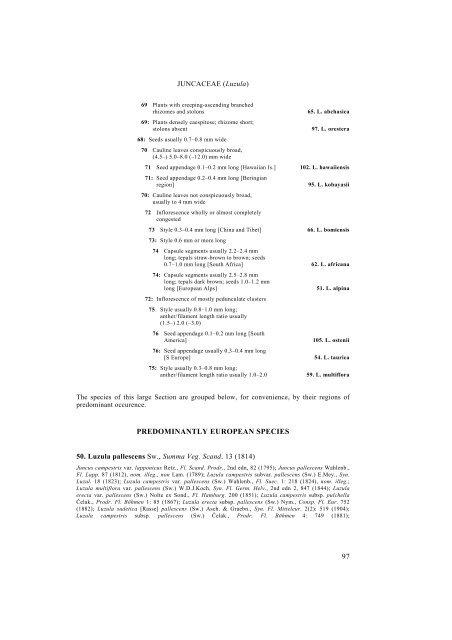Part 6. JUNCACEAE 1: Rostkovia to Luzula - Species Plantarum ...
Part 6. JUNCACEAE 1: Rostkovia to Luzula - Species Plantarum ...
Part 6. JUNCACEAE 1: Rostkovia to Luzula - Species Plantarum ...
Create successful ePaper yourself
Turn your PDF publications into a flip-book with our unique Google optimized e-Paper software.
<strong>JUNCACEAE</strong> (<strong>Luzula</strong>)<br />
69 Plants with creeping-ascending branched<br />
rhizomes and s<strong>to</strong>lons 65. L. abchasica<br />
69: Plants densely caespi<strong>to</strong>se; rhizome short;<br />
s<strong>to</strong>lons absent 97. L. orestera<br />
68: Seeds usually 0.7–0.8 mm wide<br />
70 Cauline leaves conspicuously broad,<br />
(4.5–) 5.0–8.0 (–12.0) mm wide<br />
71 Seed appendage 0.1–0.2 mm long [Hawaiian Is.] 102. L. hawaiiensis<br />
71: Seed appendage 0.2–0.4 mm long [Beringian<br />
region] 95. L. kobayasii<br />
70: Cauline leaves not conspicuously broad,<br />
usually <strong>to</strong> 4 mm wide<br />
72 Inflorescence wholly or almost completely<br />
congested<br />
73 Style 0.3–0.4 mm long [China and Tibet] 6<strong>6.</strong> L. bomiensis<br />
73: Style 0.6 mm or more long<br />
74 Capsule segments usually 2.2–2.4 mm<br />
long; tepals straw-brown <strong>to</strong> brown; seeds<br />
0.7–1.0 mm long [South Africa] 62. L. africana<br />
74: Capsule segments usually 2.5–2.8 mm<br />
long; tepals dark brown; seeds 1.0–1.2 mm<br />
long [European Alps] 51. L. alpina<br />
72: Inflorescence of mostly pedunculate clusters<br />
75 Style usually 0.8–1.0 mm long;<br />
anther/filament length ratio usually<br />
(1.5–) 2.0 (–3.0)<br />
76 Seed appendage 0.1–0.2 mm long [South<br />
America] 105. L. ostenii<br />
76: Seed appendage usually 0.3–0.4 mm long<br />
[S Europe] 54. L. taurica<br />
75: Style usually 0.3–0.8 mm long;<br />
anther/filament length ratio usually 1.0–2.0 59. L. multiflora<br />
The species of this large Section are grouped below, for convenience, by their regions of<br />
predominant occurence.<br />
PREDOMINANTLY EUROPEAN SPECIES<br />
50. <strong>Luzula</strong> pallescens Sw., Summa Veg. Scand. 13 (1814)<br />
Juncus campestris var. lapponicus Retz., Fl. Scand. Prodr., 2nd edn, 82 (1795); Juncus pallescens Wahlenb.,<br />
Fl. Lapp. 87 (1812), nom. illeg., non Lam. (1789); <strong>Luzula</strong> campestris subvar. pallescens (Sw.) E.Mey., Syn.<br />
Luzul. 18 (1823); <strong>Luzula</strong> campestris var. pallescens (Sw.) Wahlenb., Fl. Suec. 1: 218 (1824), nom. illeg.;<br />
<strong>Luzula</strong> multiflora var. pallescens (Sw.) W.D.J.Koch, Syn. Fl. Germ. Helv., 2nd edn 2, 847 (1844); <strong>Luzula</strong><br />
erecta var. pallescens (Sw.) Nolte ex Sond., Fl. Hamburg. 200 (1851); <strong>Luzula</strong> campestris subsp. pulchella<br />
Čelak., Prodr. Fl. Böhmen 1: 85 (1867); <strong>Luzula</strong> erecta subsp. pallescens (Sw.) Nym., Consp. Fl. Eur. 752<br />
(1882); <strong>Luzula</strong> sudetica [Rasse] pallescens (Sw.) Asch. & Graebn., Syn. Fl. Mitteleur. 2(2): 519 (1904);<br />
<strong>Luzula</strong> campestris subsp. pallescens (Sw.) Čelak., Prodr. Fl. Böhmen 4: 749 (1881);<br />
97












